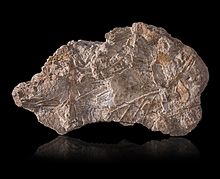
Back حميت Arabic Gueiserita Catalan Sinter German Geiserita Spanish Geysérite French 규화 (단백석) Korean Geyseritt NN Gejzeryt Polish Кремнистый туф Russian கீசரைட்டு Tamil

Geyserite, or siliceous sinter, is a form of opaline silica that is often found as crusts or layers around hot springs and geysers. Botryoidal geyserite is known as fiorite. Geyserite is porous due to the silica enclosing many small cavities.[1] Siliceous sinter should not be confused with calcareous sinter, which is made of calcium carbonate.
In May 2017, evidence of the earliest known life on land may have been found in 3.48-billion-year-old geyserite uncovered in the Pilbara Craton of Western Australia.[2][3]

- ^ "Sinter | mineral".
- ^ Staff (9 May 2017). "Oldest evidence of life on land found in 3.48-billion-year-old Australian rocks". Phys.org. Retrieved 13 May 2017.
- ^ Djokic, Tara; Van Kranendonk, Martin J.; Campbell, Kathleen A.; Walter, Malcolm R.; Ward, Colin R. (9 May 2017). "Earliest signs of life on land preserved in ca. 3.5 Ga hot spring deposits". Nature Communications. 8: 15263. Bibcode:2017NatCo...815263D. doi:10.1038/ncomms15263. PMC 5436104. PMID 28486437.